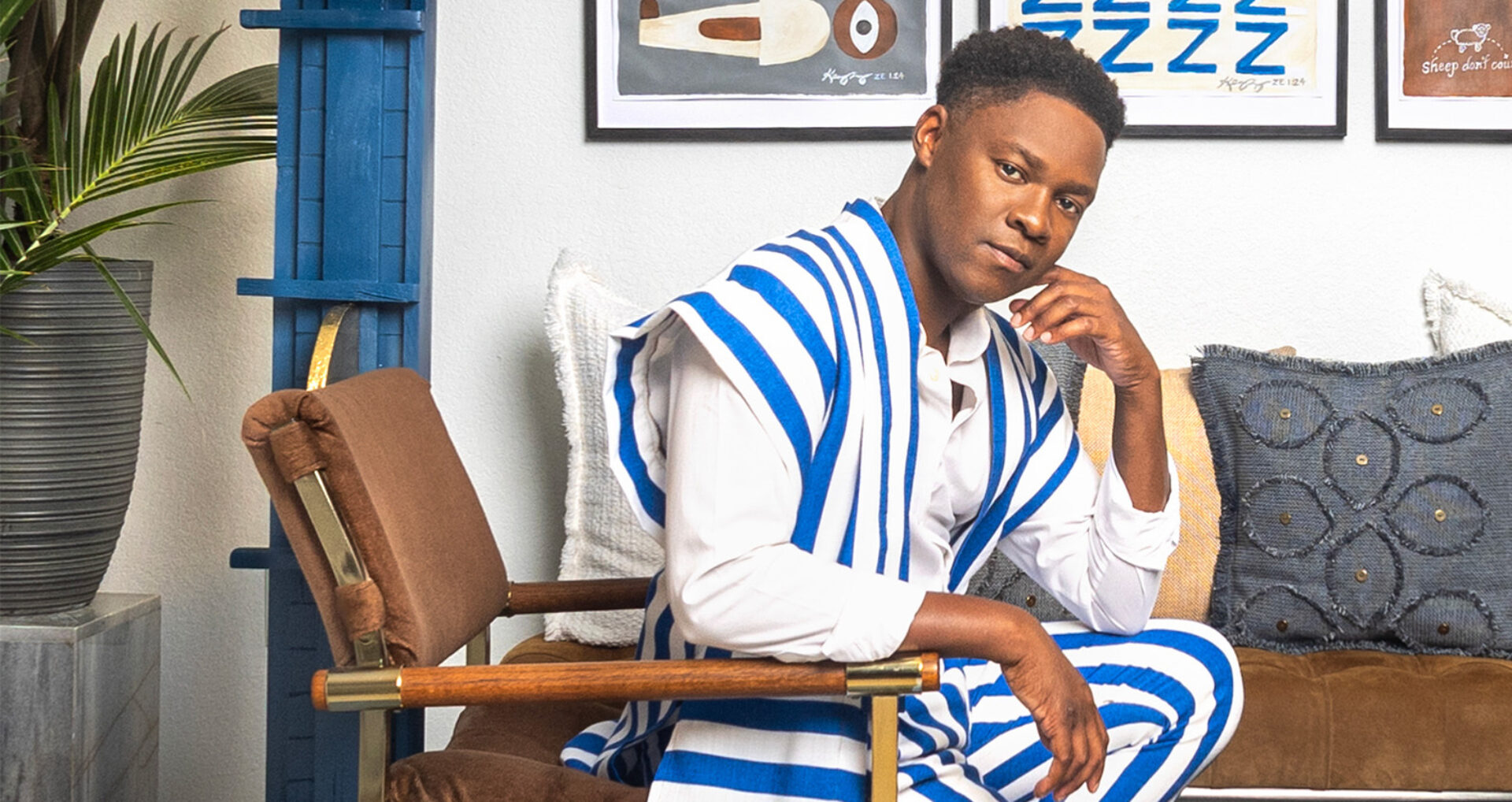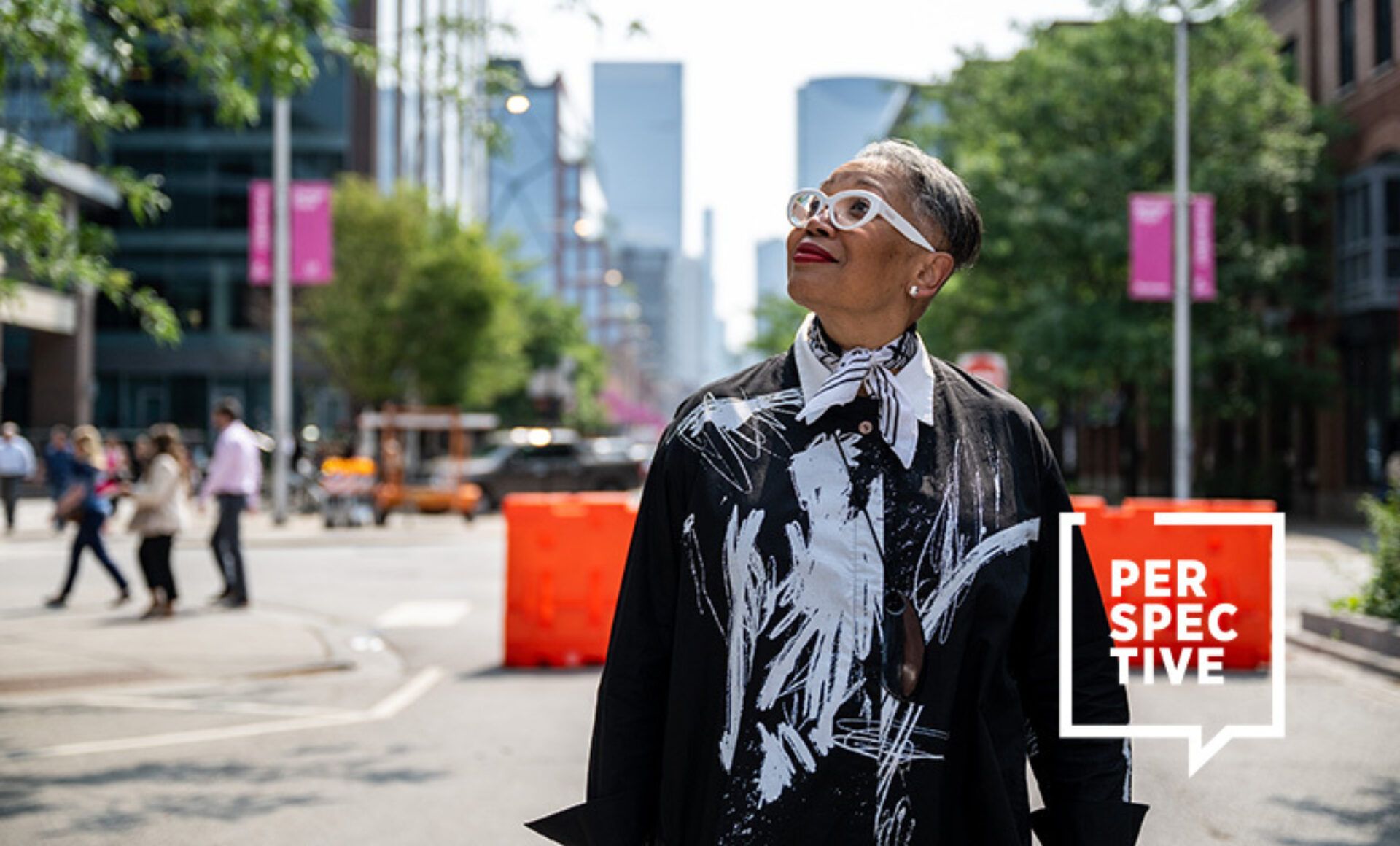Impeccably dressed, exceedingly creative, and endlessly inspiring, Kenzie Leon Perry is, in many ways, larger than life. In this issue of Perspective, unpacking the state of education, we turn our focus to the Miami-based designer whose creative vision extends well beyond the interiors he curates. As the creative director of Ze Haus Design Studio, Perry’s work spans hospitality, commercial, and residential spaces, all brought to life through his signature design style, which he calls “Tropic Art Nuvo”—a blend of bold colors, natural materials, and hand-painted murals inspired by his Caribbean roots.
But Perry’s impact isn’t limited to design. He’s also an adjunct professor at Florida International University and an instructor in IIDA’s Design Your World program, where he mentors the next generation of designers, especially those from communities that are underrepresented in the design industry. With a background that stretches from music to visual arts, Perry approaches design holistically, seeing it as an opportunity not just to shape spaces, but to empower people. In this conversation, Perry shares his thoughts on the future of design education, the importance of diversity in the classroom, and how his love for the tropics has shaped a career that’s anything but conventional.
Can you explain what “Tropic Art Nuvo” means to you and how it reflects your design philosophy?
Tropic Art Nuvo is a phrase I coined, inspired by the Art Nouveau era, a design style that lasted from around 1890 to 1910. Tropic Art Nuvo contrasts traditional Art Nouveau with bold, saturated colors and a focus on tropical elements. The modernized spelling of “Nuvo” was intentionally chosen to differentiate the two styles and emphasize the unique, contemporary approach of my work, setting it apart from the historical aesthetic of Art Nouveau.
Tropic Art Nuvo is deeply rooted in nature, incorporating biophilic elements and materials like natural fibers, finishes, and organic textures, all harmonized with bold hues and dynamic patterns. This philosophy shines through in the use of nature- and wildlife-themed wallpaper, warm wooden finishes, and organic accessories, complemented by carefully selected retro furniture that gives each space a curated, distinctive character.

How has your time spent in Miami and the Caribbean shaped your design approach?
Growing up in Miami and frequently traveling to the Caribbean, I’ve been profoundly influenced by the vibrant neighborhoods with brightly colored homes, lush tropical landscapes, and the lively, flamboyant culture. These elements have shaped my unique approach to design, blending the rich visual and cultural aesthetics of both regions. Miami and the Caribbean are intrinsically connected, not only by geography but also by the shared experiences of the people who call them home.
Having transitioned from music to interior design and then to product and visual art, how has your diverse background influenced your creative process?
My diverse background has shaped my creative process by allowing me to approach design holistically, integrating rhythm, composition, and storytelling across all mediums. Music taught me about harmony, flow, and emotional resonance, which I now translate into the spatial arrangements and atmosphere of interior design. My experience in product and visual art enhances my understanding of form, texture, and scale, enabling me to craft cohesive and layered environments. Each discipline has contributed a unique lens through which I approach creativity, resulting in work that is both visually compelling and deeply expressive. This interdisciplinary foundation helps me think outside of traditional design boundaries, blending art, design, and functionality into a unified vision.

Dale Stine Photography

As a mentor in IIDA’s Design Your World program, what drew you to participate in the first place? How do you guide minority students as they navigate the early stages of their careers, and what lasting impact do you hope to leave?
I often say that IIDA’s Design Your World program found me, rather than the other way around. I was drawn to it naturally because it aligned perfectly with my passion for interior design and my desire to give back. Initially, I didn’t realize the profound impact the program would have on me—more so than the impact I could bring to it.
When guiding my students, I focus on teaching the core principles of interior architecture while encouraging them to think beyond limits. Design is a universal language, and its application extends across many disciplines. I urge young designers to stay curious, be creative, build meaningful connections, and most importantly, enjoy the process.
My experience with Design Your World and design education has inspired me to start writing instructional design books, with the hope of leaving a lasting legacy for future generations of aspiring designers.
You illustrated the children’s book Design Your World. How did your experiences as a designer and educator influence the story, and what do you hope children take away from it?
Illustrating Design Your World was a significant milestone, especially since it was my first time illustrating a book. I drew inspiration from personal relationships and intuition to develop the design concepts and rendering style. As a designer, I had to carefully consider how each scene’s spatial layout would be interpreted by the reader. Every piece of furniture, accessory, and artwork was intentionally placed to leave negative space for the text on each page.
Creating perspective and depth was crucial, with vanishing points carefully considered to bring the scenes to life. I also adapted the illustrations into vignettes as needed to ensure the story was told effectively. While the story is fictional, I wanted the functionality of the spaces to feel real because, as a designer, I pay close attention to details that enhance practicality. I wanted the illustrations to reflect that same sense of realism.
Additionally, I used my understanding of color theory to craft specific color palettes that matched the mood and tone set by the authors. My hope is that children will see themselves reflected in [the protagonist] Serena’s journey and feel inspired to take creative control of their own spaces—or even aspire to become creative professionals when they grow up.

Josue Louis Photography

What has been your most rewarding experience as an educator and mentor? Has anything about being a design educator surprised you—perhaps something you didn’t predict about teaching design?
My most rewarding experience as an educator has been witnessing each student’s unique growth and how they develop their individual potential as design creatives. Students come in with varying levels of skill and design knowledge, but many of them excel rapidly once they grasp the foundations of interior architecture. It’s incredibly fulfilling when their progress exceeds my expectations; they not only inspire me but also teach me valuable lessons about becoming a better designer and educator.
This experience has shaped my approach by teaching me to be more open, approachable, and willing to give students greater agency in shaping the curriculum and their project goals. As a result, I’ve become more experimental in my own design practice. What continues to surprise me is the creativity, adaptability, and resilience that students demonstrate—often surpassing the high expectations I set—by the end of each session.
This issue of Perspective has design education as its axis. With global challenges like sustainability and evolving technology, how do you see design education adapting to prepare students for the future?
One of the greatest challenges educators face today is the rise of artificial intelligence. AI is undeniably the future, and it’s here to stay. While there are concerns about its misuse, my fellow educators and I have discussed how it can be harnessed as a valuable collaborative tool for conceptualizing and inspiring design. Just as there was initial hesitation with the introduction of earlier design applications, embracing AI with a clear understanding of its capabilities has the potential to advance the field significantly.

Interior architecture is a demanding discipline, and AI can help us work more efficiently by streamlining tasks and allowing designers to focus on creativity and problem-solving. Ultimately, this technology can make our design practices more responsive to the needs of the end user, leading to better outcomes.
What skills do you think design students today need to thrive in an ever-changing industry?
One of the most important skills I emphasize to students is the art of hand sketching. After nearly two decades in the industry, I’m still adapting to new design technologies, but hand sketching remains an essential tool for quick conceptualization and effective communication with clients and teams. It’s a valuable, low-cost skill that allows for fluid, spontaneous expression, free from the limitations of technology.
Equally important are research, listening, and inquiry skills. I often encounter students who are accustomed to being guided through every step, rather than taking initiative and going beyond the basic requirements to produce exceptional work. Developing autonomy in this regard is critical.
Lastly, students must refine their graphic design skills. Too often, I see minimal effort put into graphic communication, yet it’s vital. Understanding human behavior and using it to engage and capture the viewer’s attention is key to selling design ideas effectively.
How can design educators better support diversity and inclusion in the classroom and beyond?
By intentionally introducing students to minority designers and design aesthetics that reflect their cultural identities. Educators should also share their own heritage and design influences to foster dialogue and visibility. While skin pigmentation is often seen as a marker of cultural identity, it’s important to recognize that diversity goes beyond skin color. If we take the time to explore our heritage, we’ll discover that diversity runs deep in all of us. Unfortunately, the racial divide in America often narrows our focus to skin color alone, when we are so much more—a vibrant mosaic of cultures. Design education should reflect this by giving equal attention to diverse design styles and backgrounds.
Visit the table of contents for more Perspective: State of Education







